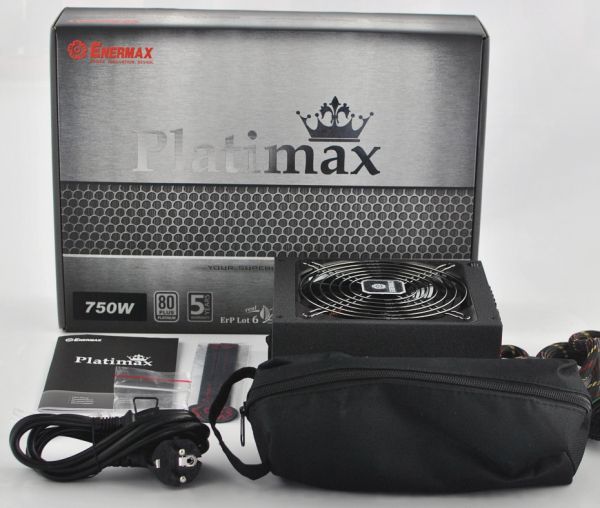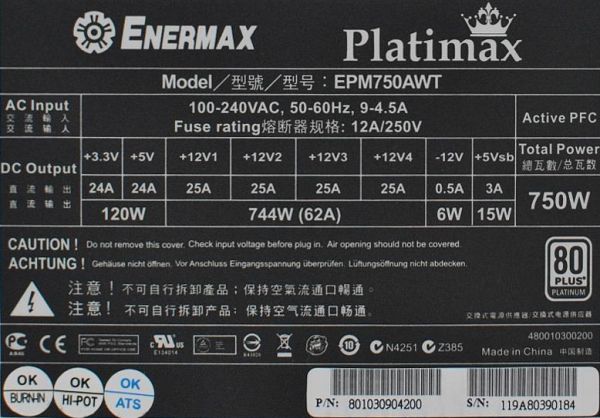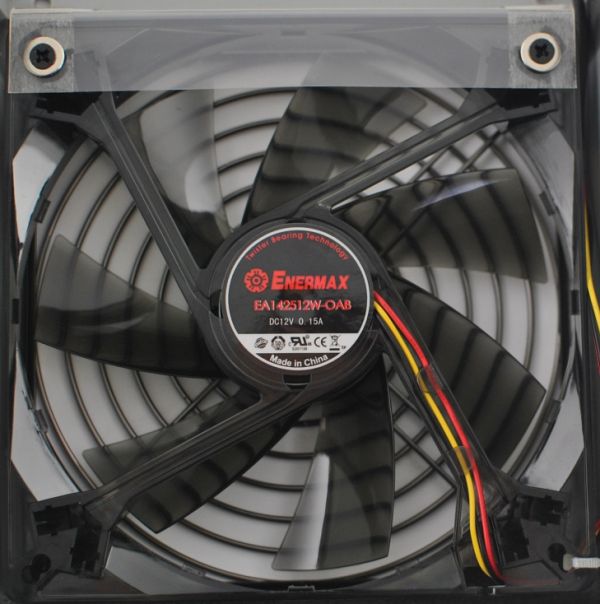Enermax Platimax 750W - 80 Plus Platinum Arrives
by Martin Kaffei on February 10, 2012 6:00 PM EST- Posted in
- Cases/Cooling/PSUs
- PSUs
- 80Plus
- 750W
- Enermax
- 80Plus Platinum
Package Contents, Power Rating, and Fan
The contents in the package are very generous. Besides the so-called "CordGuard" that secures the power cord, users get some Enermax cable ties, an Enermax sticker, a user manual, and the modular cables in a separate bag. Features of the product include the 80 Plus Platinum certificate, a 5 year warranty, the improved resonant converter, and other technical refinements; we'll cover those in more detail later. There is also a "HeatGuard", which is nothing more than a temperature monitor that will continue to cool the PSU after you shut off the PC/PSU (if necessary).
According to the label the PSU has four +12V outputs rated at 25A each, which together can provide almost the entire power output (744W). Both +3.3V and +5V are specified at 24A. Those outputs can provide up to 120W, which is slightly lower than the values from most power supplies in this performance class but typically more than sufficient for modern PCs. The +5VSB at 3A is also relatively strong.
Enermax relies on its own high-quality Twister fan for cooling, with the model number EA142512W-OAB. This one has seven transparent fan blades and is based on Enermax's "Twister Bearing". The fan is rated at just 0.15A current, which is rather moderate. The fan runs at low speeds ranging from 300 to 1000RPM. Well, at least that applies to the fan in Platimax models below 1000W. Thanks to some patents, the fan has a 13.9cm diameter, but it's basically a 140mm fan.













47 Comments
View All Comments
Sabresiberian - Saturday, February 11, 2012 - link
I try to avoid having "fanboy" level emotions tied to a company, but Enermax inspires that feeling in me more than any other. That being said, I don't believe anyone should buy a PSU by brand alone; if you can't find a positive review for it, don't buy it, buy something that has been tested by independent people you trust (Anandtech and Tomshardware come to mind).Does it make sense to pay the premium price Enermax PSUs goes for? I'll tell you how I think - I've always thought it was just plain ridiculous that PSUs had cords that just plugged into the back with no way to secure them, especially higher-powered ones that draw a lot of current and can get warm and loosen up. Enermax is the only company that has addressed this issue (not to mention providing beefy power cords that aren't likely to heat up anyway), and I'm willing to pay the extra money for a product when the company pays attention to details like that.
If that means I'm paying $50 for a little wire to you, than so be it. It means I'm buying a rock-solid PSU that I won't have to replace for a decade to me, and the increased cost is minimal over that lifetime.
BTW, the 860W Platinum Seasonic is $219.99, plus shipping on top of that, at Newegg right now. Looks to me like Enermax's price for this kind of thing isn't out of line since Seasonic is a premium PSU manufacturer that isn't known for inflating its prices.
;)
pandemonium - Wednesday, February 15, 2012 - link
Or you can just not skimp on anything and have a rig that lasts forever. There's always exceptions to the rule, but more often than not, higher quality = longevity and stability; regardless of component.Of course, if you're rebuilding your computer every 6 months, then none of that really matters anyways.
Galcobar - Saturday, February 11, 2012 - link
The point of higher efficiency is the amount of power the PSU itself consumes in transforming the current in the wall from AC to DC. The components of your computer need X power, and (assuming basic quality) will receive it. The efficiency is how much power the PSU pulls from the wall (Y) to provide X power. The difference between what your computer needs and what your PSU consumes (Y-X) is wasted power, which usually means extra heat. The more efficient the PSU, the closer Y is to X and therefore the less power is wasted -- which means less money wasted and less heat generated.Quality's a separate issue. If the PSU provides unstable power, it can kill the components precisely because they're designed to work with a standard supply. Go outside that standard (specifically, the ATX standard) and electronics stary dying.
meloz - Saturday, February 11, 2012 - link
>>Our personal preference is that more is less when it comes to logos and such,I am very disappointed to hear this. I always loved how Anandtech used to put performance and functionality on top when evaluating gear, unlike websites like engadget which 'review' gear based on how it looks (mostly), with some crumbs thrown towards performance and functionality.
It was good ride while it lasted, I guess. It's all about bling-bling.
Death666Angel - Saturday, February 11, 2012 - link
Yes, because that is clearly everything this article is based on!...PrinceGaz - Saturday, February 11, 2012 - link
>>Our personal preference is that more is less when it comes to logos and suchWhilst saying "less is more" would have been more intuitive than saying "more is less", what they both mean is that at AT they *don't* like products where you've paid for a bunch of logos and other rubbish when all you really want is a PSU (or other bit of hardware) that does its job well.
I've never stuck a sticker from a PSU, CPU, graphics-card, hard-drive, software (I believe if you buy it they sometimes include a sticker along with a legal license-key) or anything else on my case.
Lord 666 - Saturday, February 11, 2012 - link
I stuck the Mossberg sticker that came with my new 590 on the outside of my computer case.Byte - Saturday, February 11, 2012 - link
Power supplies have gotten pretty insane. Really, it just converts 120V AC to 12V DC in the end. It will not make your system go ANY faster. Even getting supper expensive RAM might yield another 1-2%, You will not even get that with a power supply. Any quality power supply will be able to get your system running and overclocking all you want. I think most builders will be fine with a $40 500watt corsair. It will even handle SLI/xFire as long as you don't have the flagship cards. Power supplies are like rims on cars, it doesn't make it faster, but we are convinced we need better ones, except you can't even see the power supply.Zaranthos - Saturday, February 11, 2012 - link
As Galcobar and others have said it's about efficiency which saves you money over time. Someone else mentioned using the same PSU for 10 years which will put money back in your pocket given enough time if it's more efficient. I have a power supply in an old server that I've been using for 10+ years and it's probably not efficient at all but it's also low wattage. When building a new server that I may use for another 10+ years I will spend extra money on the PSU for all the reasons mentioned. I want to keep my monthly electric bill lower, I want less heat pumped into my house at least during the summer months when I have to run AC, and I want the power supply to last longer than any of the other components.Ph0b0s - Saturday, February 11, 2012 - link
You also pay extra for power supplies like Enermax ones, that have protection circuits for over-volting etc. I have tried the cheaper power supply route. You think it's OK, it's cheap so if it fails I can just buy another one. Well that works until it burns out a lot of your system when it fails because it had not functions to protect the rest of your system. The Enermax PSU in the rare, for them, event of a failure, fail gracefully without burning out the rest of my components. Some Enermax PSU's I have had for 10+ years now, still going strong. So expensive PSU's actually work out cheaper in the long run.